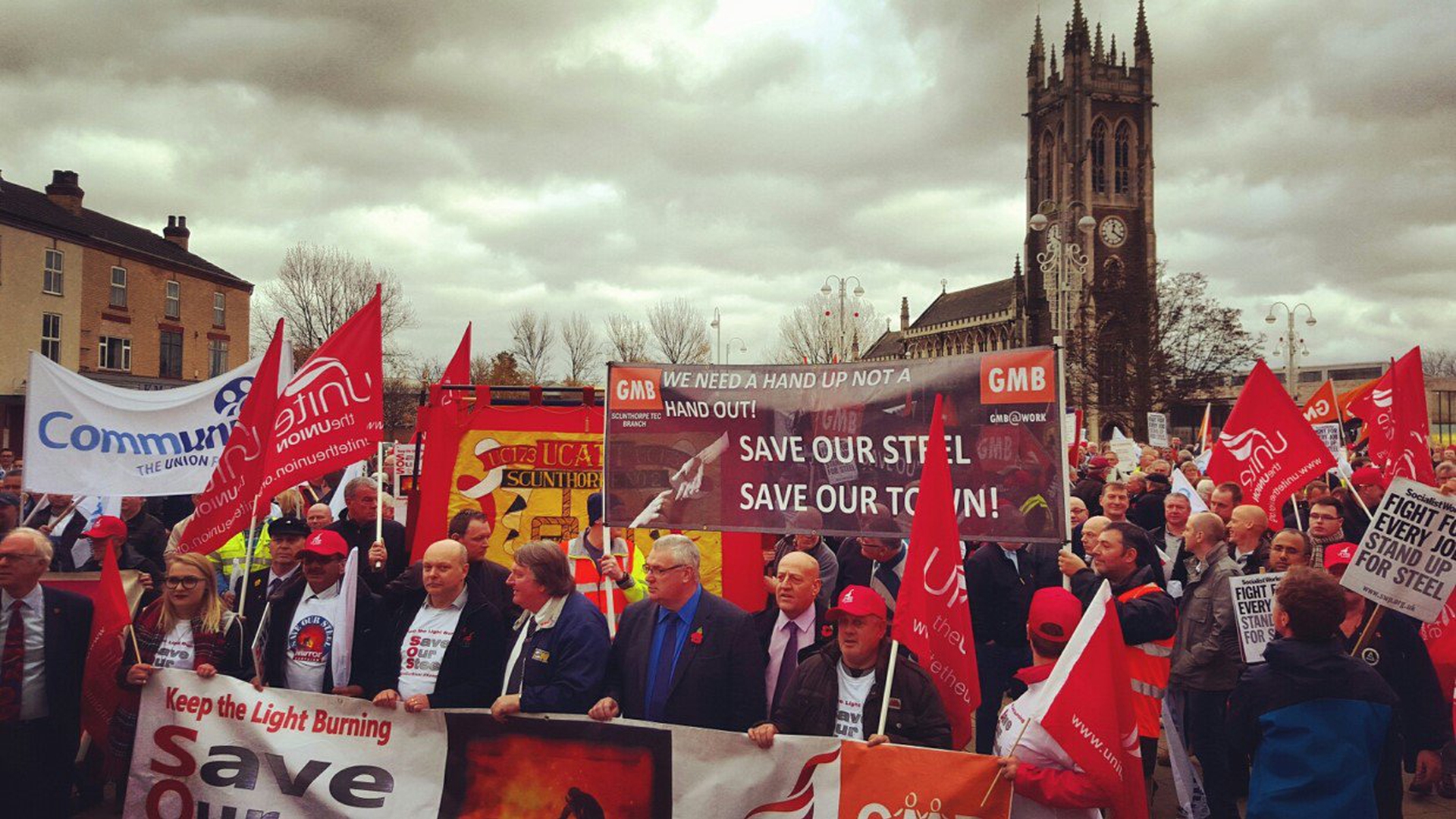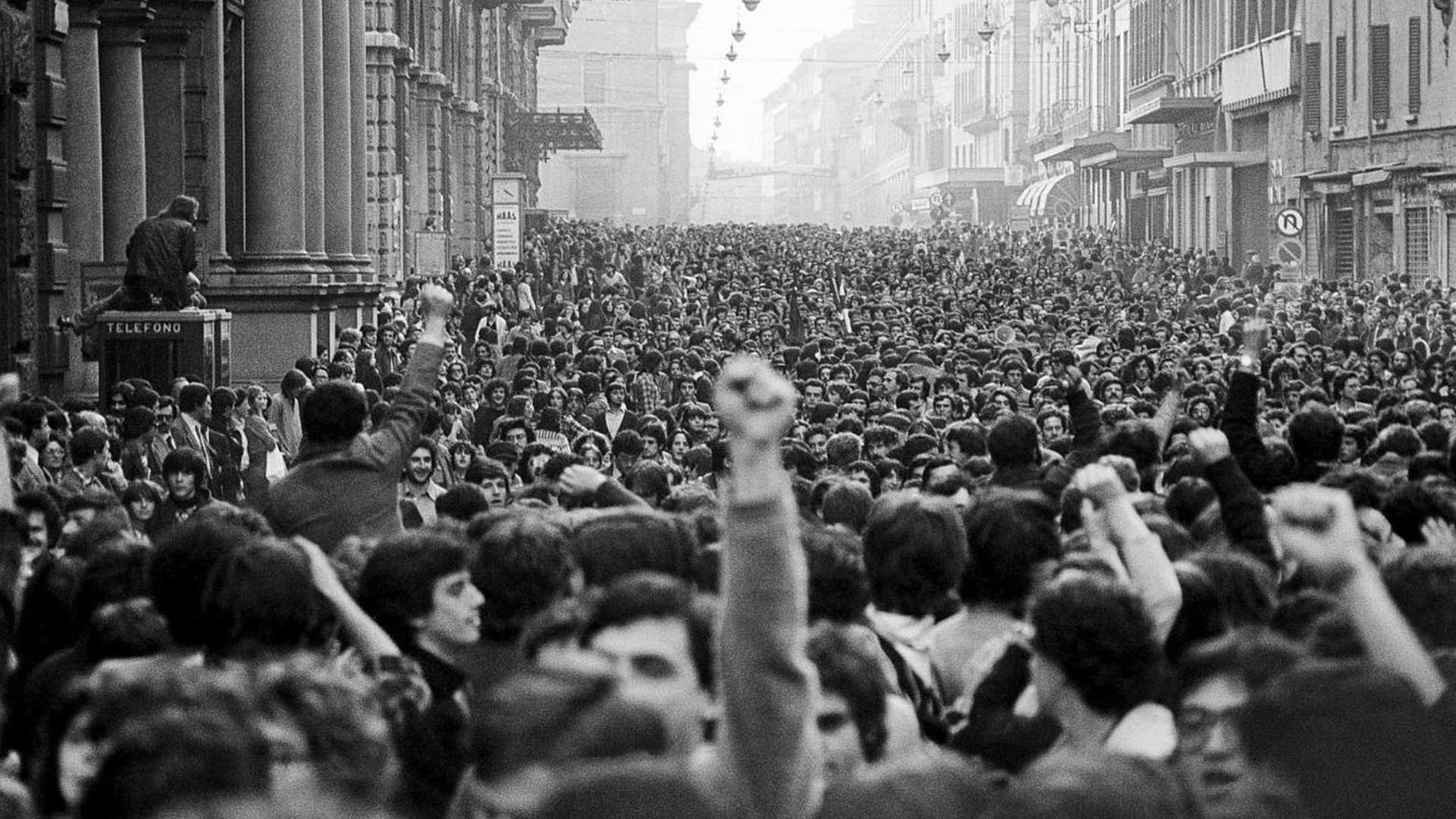Deindustrialisation and decline
by
Chris McLachlan (@c_mclachlan89)
October 27, 2018
Deindustrialisation’s implications for workers’ inquiry

inquiry
Deindustrialisation and decline
by
Chris McLachlan
/
Oct. 27, 2018
Deindustrialisation’s implications for workers’ inquiry
There emerged considerable social and economic changes in the second half of the 20th century through processes of deindustrialization, most notably in the Global North. At face value, deindustrialization represents the decline of heavy industrial activity, particularly in the manufacturing sector – such as deep coal mining, steel production, textiles, automotive production, or the docking industry – in a defined region or economy. Importantly, these regions and localities are often monoindustrial communities where the industrial unit, whether a pit or a factory, is the primary social and economic base of that area, highlighting a crucial geographical dimension to deindustrialization.
Affected countries have experienced significant restructuring of their economies due to the decline of manufacturing, with consequent shifts in employment levels in different sectors of the economy. Taking the UK as an example, it is well known that since the 1980s the finance and service sectors have proliferated, both in terms of GDP and employment metrics. Data shows that employment in manufacturing dropped from 38.1% in 1973 to 8.9% in 2018, compared to the service sector which jumped from 54.4% in 1973 to 80.2% in 2018.1
This loss of jobs in manufacturing as a result of deindustrialization has been described as the ‘body count’. This is a useful metaphor for questioning the narrative typically ascribed to the decline of heavy industry. Media commentators and government officials typically foreground the shock value of the absolute numbers of job losses, framing this through the notion that associated industries represent a certain nostalgia consigned to history. Arguably, this views deindustrialisation as an inevitable fact rather than an ongoing socio-economic process. Doing so thus undermines the experiences of workers and communities who have been, or continue to be, affected by the profound effects wrought on their livelihoods, and the restructuring of their regions.
Discussions around deindustrialisation tend to counterpose its perceived negative aspects, such as the statistics around job loss and redundancy, by promoting the view that we are now in a ‘post-industrial’ economy. Broadly speaking, debates around a post-industrial economy have centred on the rise of the digital technologies and the service sector, in terms of its size of GDP in proportion to manufacturing. This has meant that future strategic investments by governments and business alike have focused efforts on advancing this area of the economy. This usually relates to championing ‘newer’ forms of work in the knowledge economy and industries associated with modern, technological development.
Indeed, the UK government published an Industrial Strategy white paper in 2017 outlining its approach to equipping individuals with the technical and digital skills required to navigate this post-industrial terrain. A range of new qualifications and educational initiatives, along with a series of revamped institutional arrangements to implement the industrial strategy, have been devised to meet these challenges. When we consider the place of workers affected by the decline in manufacturing, there are proposals for a National Retraining Scheme, co-ordinated by the Confederation of British Industry and the Trades Unions Congress, which aims to help those who have lost their jobs re-enter the labour market with a more apposite set of skills for the 21st century.
A problem with this rhetoric, however, lies in the tendency to view workers affected by deindustrialization as simply passive actors in a process of significant social and economic upheaval. This is not to say that a focus on initiatives to encourage workers to retrain through obtaining new qualifications and learning new skills, or that strategic investments into a post-industrial economy, are misguided. In understanding the experiences of workers affected by, say, episodic rounds of restructuring in the UK steel industry, the post-industrial rhetoric fails to address how such critical events are associated not only with workers being made redundant but a fundamental reshaping of regional economies and local communities.
The social implications of deindustrialization in the UK
Whilst the deindustrialization process clearly has economic implications, an oft-forgotten aspect of the debate are the challenges posed for the social, political and cultural life of the regions in which heavy industry is, or was, located. Put simply, the effects of deindustrialization cannot be easily understood only at the moment an employment contract is terminated. Rather, a wider understanding of its impact on the social networks of communities and how this contributes to the future prosperity of a region is required. That is, what resources are available to support workers and communities in adjusting to the ongoing social and economic restructuring of their regions, when heavy industry and manufacturing has pervaded their lives for so long? Traditional support mechanisms have revolved around the importance of trade unions and occupational communities, which are intimately woven throughout industries affected by deindustrialization. This raises questions about how the social composition of workers shapes their response to, or resistance against, processes of restructuring and capitalist development have run in parallel to deindustrialization. Notably, technical shifts in production, such as the introduction of new technologies and mechanisation, have also fragmented the spaces in which workers built collective power. Whether this involved workers learning new skills or changing jobs completely, the sense of a shared labour process often acts as a basis of shared experience and thus forms a key feature of the social composition of the workforce.
A recent example in the UK helps illuminate the ongoing struggles facing industrial communities. In December 2015, the last deep coal mine in the UK closed in Kellingley, North Yorkshire. This brought an end to a centuries old mining industry in the UK. The closure of the last pit came, however, some 30 years after Margaret Thatcher and her Conservative government launched an attack on the coal mining industry. Thatcher’s government implemented plans to close supposed ‘uneconomic’ pits in what led to one of the longest industrial strikes in recent history when the National Union of Mineworkers took action for a year from 1984-5. Though ultimately a poignant defeat for the industry and trade unionism alike, in the 30 years after the events of 1980s the coal mining industry has continued to decline with workers and related communities having to deal with the consequent loss and hardship. Clearly, the end of the strike in 1985 was not the end of the story for mining communities. That said, it is worth acknowledging that it was the social composition of miners and their communities that provided the circumstances in which a strong, mass strike was possible. Solidary extended beyond miners to families and other community groups (as illustrated in Ken Loach’s Pride), with support widespread in both work and non-work spheres. By drawing whole communities together in this way, however, exacerbated the consequences of future struggles, resulting in wider sense of social loss than the purely economic impact of pit closures and redundancies.
The continued effects of deindustrialization were apparent in the BBC’s two-part documentary in 2016, The Last Miners, which followed the lives of affected workers in the three months prior to the closure of last pit in Kellingley. Portrayals of life as a mineworker highlighted a strong, close-knit occupational community, with a camaraderie between workers that was formed through shared experiences of arduous, manual labour in a male dominated environment. The documentary provides an insight into what a transition into a post-industrial economy means for areas associated with ‘old-fashioned’, or even outdated, heavy industry. Though the expected bravado of a heavily masculine industry is on display, the reality of job loss on the workers themselves and their families, friends and the local area are brought into sharper focus. Material consequences related to future employability, loss of income and economic insecurity are interspersed with the impact on the social and personal lives of workers, demonstrating the pervasiveness of life as a miner.
Crucially, however, we are presented with a deep sense of loss amongst these workers and their associated communities, both socially and materially, and are offered a glimpse as to what life is like in the throes of deindustrialization. More recently, the BBC’s 2018 four-part docu-series, Welcome to Redcar, struck a similar chord with a slightly different focus, highlighting the wider societal challenges in the life courses of younger people in a region that suffered serious industrial decline following the closure of the SSI steelworks in 2015. US academic Sherry Lee Linkon describes ongoing effects of this kind as the ‘half-life of deindustrialization’,2 whereby industrial regions affected by mass restructuring continue to redefine their lives through a blurring of past and present experiences of work, showing the difficulties in simply trying to ‘pull their socks up’ or ‘get over’ the loss suffered.
Workers’ Inquiry and Deindustrialization
To further illustrate the effects of deindustrialization, especially in terms of workers’ inquiry, it is worth considering the concrete, often mundane, reality of displaced workers. One of the primary organisational responses to deindustrialization has been the cutting of jobs through managerial processes of restructuring and redundancy. Generally speaking, the implementation of restructuring can take two forms; that of outright redundancy where employees exit entirely, or through internal redeployment where their original job is redundant yet workers remain in the organisation or industry in a new, often different, role.
Clearly in industries where production has ceased, such as with coal mining, workers are necessarily made redundant and thus required to transition to new employment or alternate paid or unpaid activities. As noted, the labour process that once tied workers together is broken. This means the technical composition of these workers is not only difficult to analyse, given the main site of worker organisation has been removed, but also suggests workers held less power over their working arrangements given that certain forces, whether economic or managerial, have declared their work as redundant. Alternatively, in industries that continue to operate but considered to have largely fallen victim to deindustrialization, such as the steel industry, management’s implementation of restructuring often entails a process of internal redeployment for displaced workers. This tends to reflect long-standing agreements between trade unions and management, particularly in the UK, where the emphasis in negotiations over restructuring is to ensure no compulsory redundancies by initially exhausting volunteers for redundancy and early retirement.
During periods of restructuring there is a considerable disruption, then, to the technical composition of workers caused by this redeployment, as workers switch between different aspects of the labour process but within the same organisation. For example, when a displaced worker is redeployed from a production to a clerical role. Although the implementation of restructuring is based on a certain managerial logic – often of workforce rationalisation or a shift to new product markets – restructuring generates a sense of disorder amongst workers, as they relinquish an element of control over their labour and become more susceptible to the whims of managerial prerogative.
The class composition of deindustrialized workers
The reason it is important to recognise the technical changes wrought by deindustrialization relates to the potential implications this has for the social and political composition of workers and their communities. Through frequent processes of restructuring occupational communities are disrupted, causing workers to reassess their occupational and personal identities in line with new forms of work organisation and employment; whether that be through redundancy or redeployment. Occupational communities act as important mechanisms for the diffusing the experiences of work and are often the site where solidaristic bonds, working class culture, and social relations are nurtured. As mentioned, occupational communities are also typically characterised by the obtainment of specific, technical skill or profession; such as the shared experiences of working at the coal face or blast furnace.
Put simply, the workplace is the physical space where collective experiences of deindustrialisation are formed and understood by workers. Hence, the community infrastructures available to these workers become weakened by deindustrialization and frequent rounds of restructuring, fracturing the social and political capacity of workers to exert influence over the future prosperity of their industries and regions. Furthermore, at an organisational level, workers typically face closer supervision and oversight from management, given they are required to learn new skills and conform to managerial strategies induced by restructuring processes. Therefore, whilst an analysis of the way workers are displaced may differ, either through redundancy or redeployment, similarly disruptive consequences for the social composition of workers arise.
The historical experiences of loss and decline are an important in shaping the way affected workers and communities respond. Dealing with the effects of deindustrialization, in terms of the significant reductions in employment and productive capacity, leaves a long-lasting imprint on workers and communities. Having observed the effects on colleagues, friends, and families, there is a sense of familiarity with the experience of loss and decline associated with deindustrialization. For instance, regions such as the Yorkshire and Humber and South Wales in the UK have been particularly affected, and tend to be central in current debates. Arguably, coping with the often pernicious effects of restructuring has become an internalised feature of what it means to be an industrial worker today. In this sense, workers and communities are so used to management’s implementation of restructuring that it is no longer as much of a shock when it occurs. This suggests something of a ‘community of fate’3 amongst workers within deindustrialized regions, where the recognition of a particularly negative event, such as episodic restructuring, can elicit a collective response from the affected community.
The role of trade unions has also contributed to this process of internalization and sense of fate. An example of this can be found in the UK steel industry, where more recent bargaining strategies involve seeking concessions from management during times of restructuring, agreeing to job losses in exchange for greater influence in other areas such as in skills and training, and redeployment decisions. This cooperative and sometimes accommodating approach from unions towards management edict has arguably normalised the inevitability of restructuring to workers and communities. Given that trade unions, the institutions designed to protect workers’ interests, have tended to accept that managing loss and decline, rather than agitating against it, is the appropriate strategy for such industries.
Refocusing the debate
The debates around deindustrialization in public life should hence be conscious to these more nuanced experiences of affected workers and communities. There should thus be a refocus on the effects of deindustrialisation as a point of debate for those on the political left, so as not to lose sight of the way communities so important to the construction of left-wing politics continue to be impacted. This is perhaps even more pertinent in a climate where discussion is dominated by new and disruptive forms of work, and typically centred on the implications of a postindustrial economy. As economic restructuring of industrial regions abound, a more qualitative appreciation of the residual social, political and cultural effects for workers and communities needs to be brought forward in the discussion. Nostalgic and reflective documentaries may give us an insight into these dynamics, yet translating these into a more concrete poltical programme represents a key challenge to not only develop more balanced economic policy but to also avert any further plight of former and existing industrial regions.
In relation to workers, understanding the social and political power of traditional compositions requires some reimagination. Whilst trade union power has weakened and occupational communities have been disrupted by deindustrialization, these local institutional structures have not disappeared completely. In particular, occupational communities represent a rich source of social and political capacity amongst workers that can, and must, extend beyond the workplace. Harnessing the traditional features of occupational community – shared experiences of work, solidaristic bonds and communities of fate – and transposing them into new forms in non-work spheres and other community initiatives locally may provide workers and communities a more active participation in the social and economic restructuring of their regions. Importantly though, a recognition that the body count is not the end of the debate in the race to a post-industrial economy is required, affording greater agency to workers and communities in the struggle to shape their futures and in a way that is sensitive to their own histories and experiences of deindustrialization.
author
Chris McLachlan (@c_mclachlan89)
Subscribe to Notes from Below
Subscribe now to Notes from Below, and get our print issues sent to your front door three times a year. For every subscriber, we’re also able to print a load of free copies to hand out in workplaces, neighbourhoods, prisons and picket lines. Can you subscribe now and support us in spreading Marxist ideas in the workplace?
Read next


